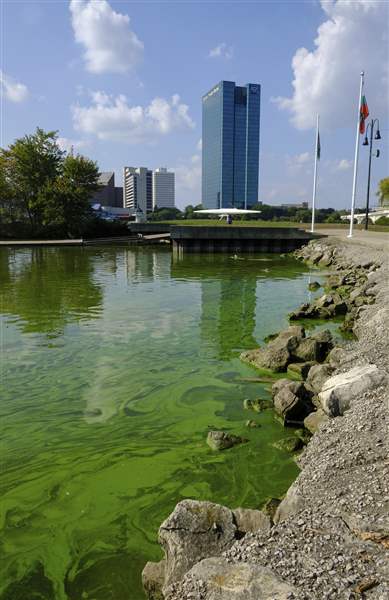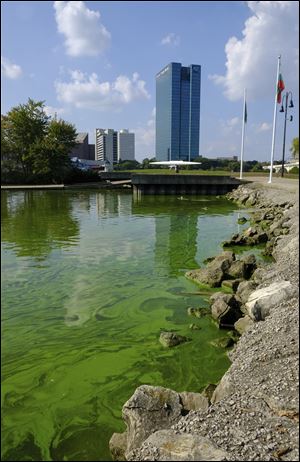
Judge slams EPA over Lake Erie impairment controversy
4/11/2018
An algae bloom appears in the boat basin at International Park in Toledo in 2017.
THE BLADE/JEREMY WADSWORTH
Buy This Image
In a decision hailed by environmental advocates as a major victory for clean drinking water, Senior U.S. District Judge James G. Carr accused the U.S. Environmental Protection Agency and the Ohio Environmental Protection Agency of botching the Lake Erie impairment controversy and, at one point, went so far as to say the federal agency demonstrated a “whiff of bad faith.”
The judge’s 25-page order, filed in Toledo on Wednesday night, gives the U.S. EPA 30 days to reconsider its failure to challenge the Ohio EPA’s controversial Oct. 20, 2016, finding that the open water of western Lake Erie did not meet criteria the state agency believed was necessary under the Clean Water Act to be designated as impaired.

An algae bloom appears in the boat basin at International Park in Toledo in 2017.
The U.S. EPA accepted the state’s finding last year, first without formally acting on it.
Then, two days after it was sued by the Chicago-based Environmental Law & Policy Center and Toledo-based Advocates for a Clean Lake Erie last May, the federal agency passed the report through its administrative process but said it was deferring to the state of Ohio’s judgment not to list the open water as impaired.
The two groups sued, claiming the U.S. EPA missed an important deadline and failed to make a final decision one way or the other. In his ruling, Judge Carr agreed that’s not good enough and remanded the case back to the federal agency.
Although the Kasich administration finally did an about-face after years of resistance on behalf of agriculture by declaring the western basin impaired on March 22, the lawsuit remains active because it is focused on the U.S. EPA’s actions as a regulator. Judge Carr said he will continue to “retain jurisdiction over this suit and all matters affecting it.”
Lake Erie’s western basin has been plagued by chronic bouts of algae toxic enough to make people sick or possibly even die since 1995. The impairment controversy has drawn a lot of attention, because the designation allows for unprecedented controls on sources of algae-forming pollution, which today is primarily agricultural runoff.
“Ohio’s persistent failures came to a head in 2016,” according to Judge Carr’s order, which said the state’s reluctance to declare western Lake Erie as impaired goes back to at least 2012. That’s two years before Toledo’s high-profile 2014 water crisis, when the city’s tap water was so fouled by an algal toxin that the metro area’s 500,000 residents were told by health officials to avoid it for almost three days.
The state agency could have made the declaration in biennial reports submitted in 2012, 2014, or 2016, but its “rebuke put the U.S. EPA in a difficult position,” the judge wrote.
While stating the federal agency “had, in effect, given Ohio a pass,” the judge also wrote that Ohio ignored its “opportunity and its duties” as a regulator. Judge Carr further stated that the U.S. EPA compounded Ohio’s inaction with more inaction by failing to act on the state’s 2016 report for nearly five months. The judge wrote that lack of oversight occurred despite Ohio’s “unmistakable failure to do what it promised the U.S. EPA it would do after 2014.”
He seemed particularly upset by the U.S. EPA waiting until a federal holiday — Jan. 15, Martin Luther King, Jr., Day and one day before his Jan. 16 deadline for motions — to tell the Ohio EPA in writing it was having second thoughts about the state’s refusal up to that point to declare western Lake Erie impaired.
Judge Carr said he was never notified — formally or informally — by the U.S. EPA, and heard about the new development in a roundabout way, from a clerk who passed down word from the ELPC.
“Defendants’ oversight amplifies the whiff of bad faith arising from the timing of its inexplicably delayed notice to plaintiffs’ counsel,” he wrote.
The judge also said he recognizes that farm runoff is much more complicated than sewage discharges and other point sources. In his decision, he noted that U.S. EPA counsel stated during oral arguments that meaningful reductions in farm runoff could take eight to 23 years.
Howard Learner, ELPC executive director, said he was impressed by the tone of Judge Carr’s remarks.
He said the judge called out both agencies for “bad faith and procedural maneuverings” and said the Ohio EPA “has dodged and weaved its statutory obligations over the years.”
“The judge, in effect, is saying ‘Quit playing games,’” Mr. Learner said. “This is a good day for the public and a good day for safe, clean drinking water.”
Mike Ferner, ACLE founder, said he hopes Judge Carr retains jurisdiction for a long time.
The U.S. EPA and the Ohio EPA declined comment. Both agencies said they are still reviewing the order.
Contact Tom Henry at thenry@theblade.com, 419-724-6079, or via Twitter @ecowriterohio.